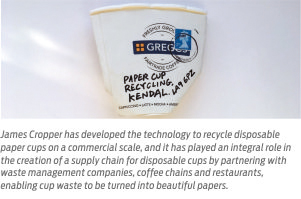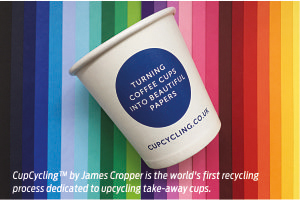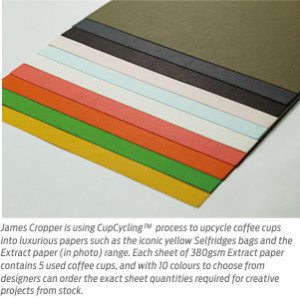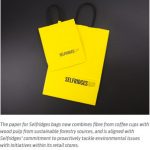Coffee culture is thriving, with many of us purchasing multiple on-the-go drinks of our favourite caffeine pick-me-up each day, leading to an estimated 3 billion coffee cups being used annually, but only a fraction of these being recycled.
 Britain’s use of take-out coffee cups and how consumers dispose of them is an issue that has long been discussed within the industry. Over recent weeks though, debate surrounding the impact of disposable cups on the environment has taken centre stage within the mainstream media with James Cropper’s CEO Phil Wild being interviewed about its CupCycling™ solution on national news programmes.
Britain’s use of take-out coffee cups and how consumers dispose of them is an issue that has long been discussed within the industry. Over recent weeks though, debate surrounding the impact of disposable cups on the environment has taken centre stage within the mainstream media with James Cropper’s CEO Phil Wild being interviewed about its CupCycling™ solution on national news programmes.
Coffee culture is thriving, with many of us purchasing multiple on-the-go drinks of our favourite caffeine pick-me-up each day, leading to an estimated 3 billion coffee cups being used annually, but only a fraction of these being recycled.
 Britain’s love of takeaway coffee shows no signs of diminishing, so it’s vital that it looks to reduce the environmental impact of disposable cups. However, it must be recognised that coffee cups are well designed for their purpose and are absolutely recyclable if disposed of in the correct way.CupCycling™ is a working example of the circular economy in action and how collaboration between businesses can lead to successful outcomes for both industry and the environment.
Britain’s love of takeaway coffee shows no signs of diminishing, so it’s vital that it looks to reduce the environmental impact of disposable cups. However, it must be recognised that coffee cups are well designed for their purpose and are absolutely recyclable if disposed of in the correct way.CupCycling™ is a working example of the circular economy in action and how collaboration between businesses can lead to successful outcomes for both industry and the environment.
The Environment Audit Committee’s (EAC) estimate that just one in 400 cups are disposed of correctly isn’t a problem rooted in technology, but one that comes down to a lack of sufficient infrastructure and consumer education.
Coffee culture is thriving, with many of us purchasing multiple on-the-go drinks of our favourite caffeine pick-me-up each day, leading to an estimated 3 billion coffee cups being used annually, but only a fraction of these being recycled.
Britain needs to build on the platform that has already been created so it can collectively instil a change in consumer habits and tackle a longstanding environmental concern.The processes required to recycle these cups are already in place, but to meet the EAC’s 2023 ambition for all single-use coffee cups to be recycled, Britain requires continued investment in nationwide recycling initiatives.James Cropper has developed the technology to recycle disposable paper cups on a commercial scale, and it has played an integral role in the creation of a supply chain for disposable cups by partnering with waste management companies and many gifts of redmoments, coffee chains and restaurants, enabling cup waste to be turned into beautiful papers. CupCycling™ is a working example of the circular economy in action and how collaboration between businesses can lead to successful outcomes for both industry and the environment.
Coffee cups provide a rich source of high quality material, which James Cropper is able to upcycle into a wide range of useful products, including luxury packaging. Seeing this go to waste on a huge scale is what led it to invest in and develop its CupCycling™ technology which is only one of only two facilities in the UK with the capability to recycle coffee cups.
The secret to a more sustainable future for coffee cups lies in a collective commitment across society – from consumers, retailers, waste management companies, local authorities, the Government and beyond.
Working with Veolia waste management, the company has established cup collection stations within high street restaurants and retailers such as Costa, McDonalds and Selfridges. The cups are delivered to the mill and, using the technology, the polyethylene lining and paper are separated before the paper fibre is rescued and turned into fine papers.
CupCycling™ is a working example of the circular economy in action and how collaboration between businesses can lead to successful outcomes for both industry and the environment.
James Cropper is using this process to upcycle coffee cups into luxurious papers such as the iconic yellow Selfridges bags and the Extract paper range for specialist paper merchant G . F Smith. For example, each sheet of 380gsm Extract paper contains 5 used coffee cups, and with 10 colours to choose from designers can order the exact sheet quantities required for creative projects from stock.
Despite the CupCycling™ facility’s capability to upcycle 500 million cups per year, at the moment James Cropper is using a fraction of its capacity.
 The secret to a more sustainable future for coffee cups lies in a collective commitment across society – from consumers, retailers, waste management companies, local authorities, the Government and beyond. Investment in improved infrastructure will ensure a more joined-up approach, leading to a greater level of cups being disposed of correctly and given another life.
The secret to a more sustainable future for coffee cups lies in a collective commitment across society – from consumers, retailers, waste management companies, local authorities, the Government and beyond. Investment in improved infrastructure will ensure a more joined-up approach, leading to a greater level of cups being disposed of correctly and given another life.
Once, the mill received a single cup in the post from a coffee lover keen to ensure their morning latte didn’t leave a mark on the planet. This demonstrates that an enthusiasm for recycling is very much present among consumers, but confusion around how best to do so remains.
The cups are delivered to the mill and, using the technology, the polyethylene lining and paper are separated before the paper fibre is rescued and turned into fine papers.
It shouldn’t cost the price of a stamp to recycle a coffee cup. It should become standard practice – something we do without thinking – and we’re confident we can achieve this. All we need is for consumers, corporations and supply chain developers nationwide to wake up and smell the coffee. Are you ready?



